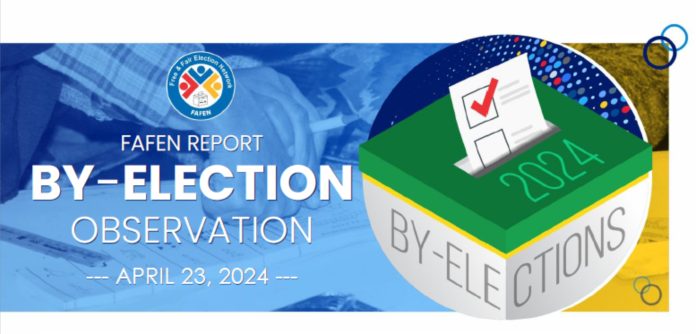By-election observation 2024 suffered a setback as security officials barred FAFEN observers from observation at 19 polling stations.
ISLAMABAD, April 23, 2024: Low voter turnout, procedural irregularities, and restrictions on independent observation in two provincial constituencies in Punjab overshadowed the improved results management and lower numbers of ballots excluded from the count during the April 21 elections in 22 national and provincial assembly constituencies, says the FAFEN report on by-election observation 2024, which was released here on Tuesday.
Polling station establishment, voter identification, and counting at polling stations were observed to have been largely compliant with the law and procedures. However, instances of omissions in ballot issuance requirements by Assistant Presiding Officers (APOs) were reported from around 14 percent of the observed polling stations. While polling agents and accredited observers generally had access to the voting and counting process, security officials or Presiding Officers barred FAFEN observers from observing the election process at 19 polling stations in PP-36 Wazirabad and PP-22 Chakwal-cum-Talagang. In PP-22, the accreditation process of FAFEN observers was also delayed until the midday on the polling day causing last-minute changes in the observation scope.
By-Election Observation 2024: Turnout Down
Nearly 36 percent of registered voters cast their votes on polling day – nine percent less than the turnout in 18 of these constituencies on February 8, 2024. Votes polled by women decreased by 12 percent, while votes polled by men declined by nine percent, despite an increase of 75,640 registered voters, including 37,684 men and 37,956 women compared to the general elections. Lahore’s five constituencies recorded the sharpest decline in the voter turnout with PP-147 reporting a mere 14 percent as against 35 percent on February 8. Similarly, NA-119 Lahore registered a 19 percent turnout against 39 percent on February 8. However, the voter turnout in Gujrat and Khuzdar constituencies recorded an increase compared to general elections.
The declining turnout was accompanied by a reduction in the number of ballots excluded from the count during the by-elections, almost halved (35,574) as compared to the number of invalid ballots (72,472) during the general elections. In addition, there were no constituencies where the rejected ballots exceeded the Margin of Victory as against four in the general election.
Release of Provisional Results
ECP issued provisional results for all the constituencies by the legal deadline of 10 a.m. of following day of the polling day despite the suspension of cellular data services in the constituencies in Balochistan, Punjab and Sindh. However, KP constituencies did not report any such disruption.
The parties that won during the general elections retained their seats in the by-elections, except in PP-36 Wazirabad and PP-93 Bhakkar. In these constituencies, PTI-backed candidate and an independent candidate had won during the general elections, but PML-N candidates emerged successful in the by-elections. These two were among the four constituencies where the margin of victory has decreased as compared to the general elections unlike the rest where the margin of victory has increased.
The by-elections were necessitated due to the death of candidates in four constituencies and vacation of seats by winning candidates in 19. PB-50 Killa Abdullah, however, went to the re-poll after a Supreme Court verdict. Of these 24, ECP notified uncontested returned candidates in NA-207 Shaheed Benazirabad-I and PS-80 Dadu-I. A PTI-backed independent candidate for NA-207 moved the Sindh High Court (SHC) to nullify the uncontested elections. He claimed the Returning Officer turned down his nomination in violation of the law.
List of Contesting Candidates
According to the Lists of Contesting Candidates (Form-33), a total of 264 candidates including 256 men and eight women contested for the 22 constituencies. Of these 264, 88 candidates represented 21 political parties, while the remaining 176 contested independently. The ECP had setup 4,238 polling stations – 935 male, 899 female and 2,404 combined – comprising 13,811 polling booths – 6,778 male and 7,033 female – to cater to more than 6.3 million registered voters.
FAFEN deployed 259 Election-Day observers, including 187 men and 72 women, to observe the voting and counting processes at 1,036 polling stations in five National Assembly and 17 Provincial Assembly constituencies (12 in Punjab, three in Balochistan and two in Khyber Pakhtunkhwa). This report is based on the observations received on Election Day from 532 polling stations through FAFEN Election Day Observation mobile application.
Click here to download complete report




